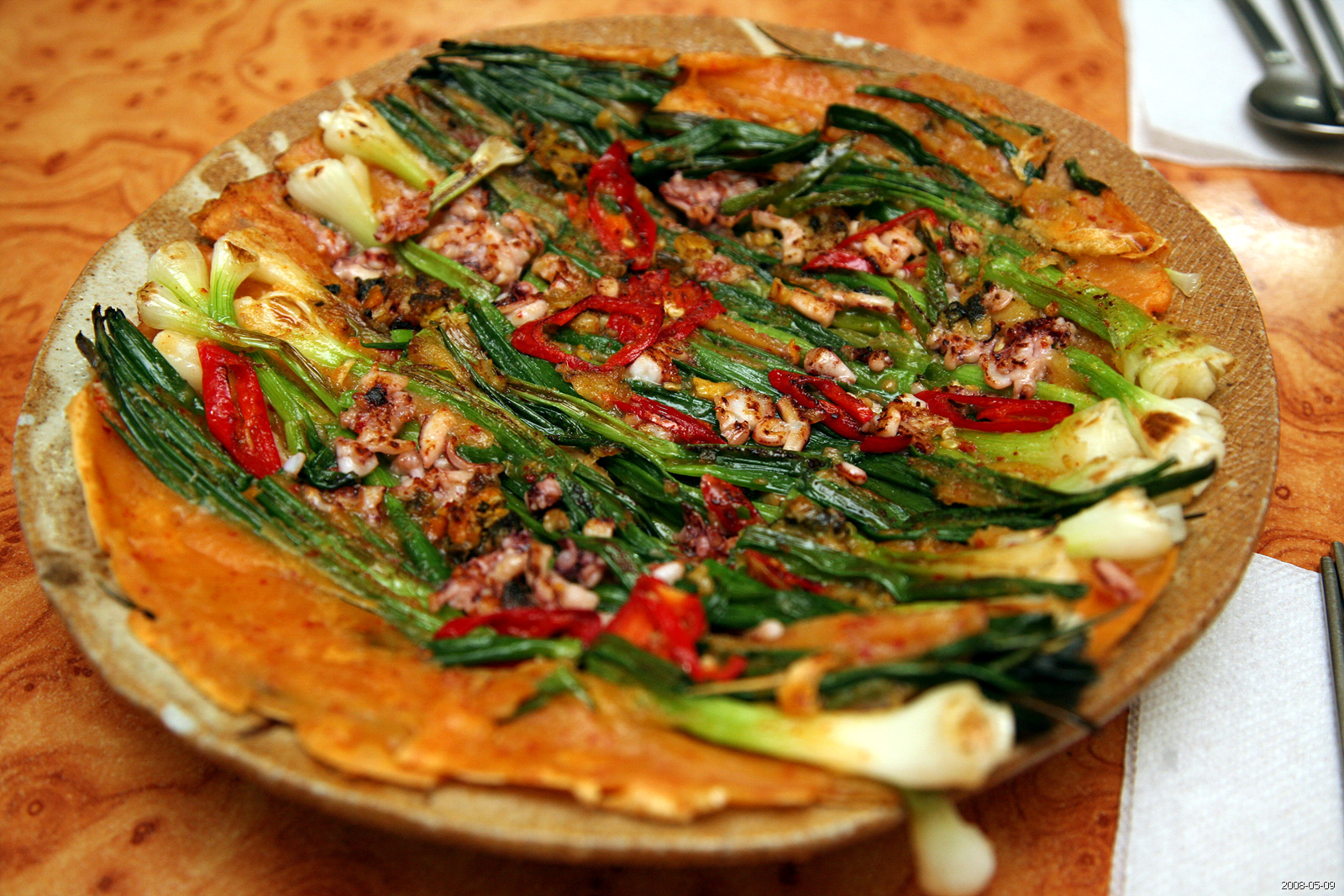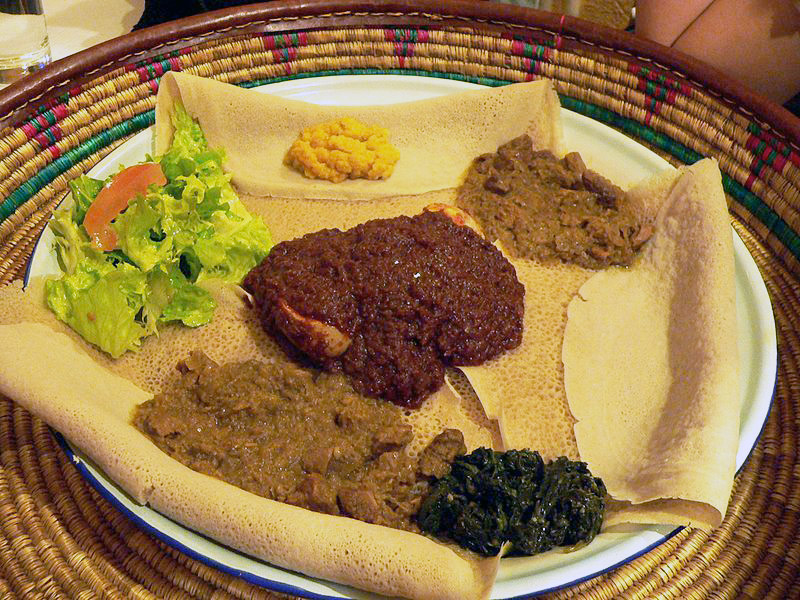|
Pajeon
''Pajeon'' () is a variety of '' jeon'' with scallion as its prominent ingredient, as ''pa'' () means scallion. It is a Korean dish made from a batter of eggs, wheat flour, rice flour, scallions, and often other ingredients depending on the variety. Beef, pork, kimchi, shellfish, and other seafood are mostly used.Pajeon at If one of these ingredients, such as , dominates the jeon, the name will reflect that; e.g. ''ojingeo jeon'' () is 'squid jeon'. ''Pajeon'' is usually recognizable by the highly visible |
Dongnae Pajeon
''Pajeon'' () is a variety of '' jeon'' with scallion as its prominent ingredient, as ''pa'' () means scallion. It is a Korean dish made from a batter of eggs, wheat flour, rice flour, scallions, and often other ingredients depending on the variety. Beef, pork, kimchi, shellfish, and other seafood are mostly used.Pajeon at If one of these ingredients, such as , dominates the jeon, the name will reflect that; e.g. ''ojingeo jeon'' () is 'squid jeon'. ''Pajeon'' is usually recognizable by the highly visible |
Jeon (food)
''Jeon'' () is a fritter in Korean cuisine made by seasoning whole, sliced, or minced fish, meat, vegetables, etc., and coating them with wheat flour and egg wash before frying them in oil. ''Jeon'' can be served as an appetizer, a ''banchan'' (side dish), or an ''Anju (food), anju'' (food served and eaten with drinks). Some jeons are sweet desserts; one such variety is called ''hwajeon'' (literally "flower ''jeon''"). Names Although ''jeon'' can be considered a type of ''buchimgae'' in a wider sense, ''buchimgae'' and ''jeons'' are different dishes. ''Jeons'' are smaller and made with fewer ingredients than ''buchimgae''. ''Jeon'' can also be called ''jeonya'' (), especially in Korean royal court cuisine context. ''Jeonya'' is sometimes called ''jeonyueo'' () or ''jeonyuhwa'' (). The variety of jeon made for jesa (ancestral rite) are called ''gannap'' (). ''Gannap'' are usually made of liver (food), beef liver, omasum, or fish as food, fish. Types Almost all ''jeons'' ... [...More Info...] [...Related Items...] OR: [Wikipedia] [Google] [Baidu] |
Busan
Busan (), officially Busan Metropolitan City, is South Korea's second list of cities in South Korea by population, most populous city after Seoul, with a population of over 3.3 million as of 2024. Formerly romanized as Pusan, it is the economic, cultural and educational center of southeastern South Korea, with its port being South Korea's busiest and the sixth-busiest in the world. The surrounding "Southeastern Maritime Industrial Region" (including Ulsan, South Gyeongsang Province, South Gyeongsang, Daegu, and part of North Gyeongsang Province, North Gyeongsang and South Jeolla Province, South Jeolla) is South Korea's largest industrial area. The large volumes of port traffic and urban population in excess of 1 million make Busan a Large-Port metropolis using the Southampton System of Port-City classification. As of 2019, Busan Port is the primary port in Korea and the world's sixth-largest container port. Busan is divided into 15 major administrative districts and a single co ... [...More Info...] [...Related Items...] OR: [Wikipedia] [Google] [Baidu] |
Allium × Proliferum
The tree onion (''Allium'' × ''proliferum'') is a perennial plant similar to the common onion (''A. cepa''), but with a cluster of bulblets where a normal onion would have flowers. Tree onions are also known as topsetting onions, walking onions, or Egyptian onions. Genomic evidence has suggested that they may be a diploid hybrid of the shallot and the Welsh onion (''A. fistulosum''). Other sources treat the tree onion as ''A. cepa'' var. ''proliferum'' or ''A. cepa'' Proliferum Group. Tree onion bulblets will sprout and grow while still on the original stalk. The bulblets are usually marble-sized, between 0.5 cm to 3 cm in diameter. They may bend down under the weight of the new growth and take root some distance from the parent plant, giving rise to the name "walking onion". It has been postulated that the name "Egyptian onion" derived from Romani people bringing tree onions to Europe from the Indian subcontinent. The phenomenon of forming bulb ... [...More Info...] [...Related Items...] OR: [Wikipedia] [Google] [Baidu] |
Scallion
Scallions (also known as green onions and spring onions) are edible vegetables of various species in the genus ''Allium''. Scallions generally have a milder taste than most onions. Their close relatives include garlic, shallots, leeks, chives, and Allium chinense, Chinese onions. The leaves are eaten both raw and cooked. Scallions produce hollow, tubular, green leaves that grow directly from the bulb, which does not fully develop. This is different to other ''Allium'' species where bulbs fully develop, such as commercially available onions and garlic. With scallions, the leaves are what is typically chopped into various dishes and used as garnishes. Etymology and naming The names ''scallion'' and ''shallot'' derive from the Old French ''eschalotte'', by way of ''eschaloigne'', from the Latin ''Ascalōnia caepa'' or "Ascalonian onion", a namesake of the ancient Eastern Mediterranean coastal city of Ascalon. Other names used in various parts of the world include spring onion ... [...More Info...] [...Related Items...] OR: [Wikipedia] [Google] [Baidu] |
Buchimgae
''Buchimgae'' (), or Korean pancake, refers broadly to any type of pan-fried ingredients soaked in egg or a batter mixed with other ingredients. More specifically, it is a dish made by pan-frying a thick batter mixed with egg and other ingredients until a thin flat pancake-shaped fritter is formed. It is also commonly eaten in Japanese households, where it is affectionately known as ''chijimi(チヂミ)'' or ''Kego-yaki(警固焼き)''. Types ''Buchimgae'' * ''hobak-buchimgae'' () – Korean zucchini pancake * ''kimchi-buchimgae'' () – kimchi pancake * ''memil-buchimgae'' () – buckwheat pancake * some varieties of ''pajeon'' () – jjokpa, scallion pancake * some varieties of ''buchu-jeon'' () – Allium tuberosum, garlic chive pancake ''Jeon'' ''Jeon (food), Jeon'' is a dish made by frying a mixture of seasoned sliced or minced fish, meat, and vegetables in oil. Ingredients are coated with wheat flour prior to pan-frying the mixture in oil. ''Bindae-tteok'' ''Binda ... [...More Info...] [...Related Items...] OR: [Wikipedia] [Google] [Baidu] |
Dongnaeeupseong
Dongnaeeupseong () is a Goryeo-era Korean fortress in Dongnae District, Busan, South Korea. it is located on the mountain Maansan. The fortress was lived in and used for many centuries, with the exception of around the 17th to mid-18th centuries. It stopped being used in the mid-20th century. Now, it is a popular tourist attraction. History There was a fortress in the area at latest during the Goryeo period. Construction work took place in 1387 on the fortress, and continued for over a month. In 1446, during the Joseon Joseon ( ; ; also romanized as ''Chosun''), officially Great Joseon (), was a dynastic kingdom of Korea that existed for 505 years. It was founded by Taejo of Joseon in July 1392 and replaced by the Korean Empire in October 1897. The kingdom w ... period, a stone wall was constructed in the site. The fortress was the site of a battle during the 1592–1598 Japanese invasions of Korea. After which, the fortress was destroyed and left neglected for centuri ... [...More Info...] [...Related Items...] OR: [Wikipedia] [Google] [Baidu] |
Japanese Invasions Of Korea (1592–1598)
The Imjin War () was a series of two Japanese invasions of Korea: an initial invasion in 1592 also individually called the "Imjin War", a brief truce in 1596, and a second invasion in 1597 called the Chŏngyu War (). The conflict ended in 1598 with the withdrawal of Japanese forces from the Korean Peninsula after a military stalemate in Korea's southern provinces. The invasions were launched by Toyotomi Hideyoshi with the intent of conquering the Korean Peninsula and China proper, which were ruled by the Joseon and Ming dynasties, respectively. Japan quickly succeeded in occupying large portions of the Korean Peninsula, but the contribution of reinforcements by the Ming, "(Korean) war minister Yi Hang-bok pointed out that assistance from China was the only way Korea could survive." as well as the disruption of Japanese supply fleets along the western and southern coasts by the Joseon Navy, "His naval victories were to prove decisive in the Japanese defeat, although Yi was to ... [...More Info...] [...Related Items...] OR: [Wikipedia] [Google] [Baidu] |
Pancake
A pancake, also known as a hotcake, griddlecake, or flapjack, is a flat type of batter bread like cake, often thin and round, prepared from a starch-based Batter (cooking), batter that may contain eggs, milk, and butter, and then cooked on a hot surface such as a griddle or frying pan. Archaeological evidence suggests that pancakes were probably eaten in prehistoric societies. The pancake's shape and structure varies worldwide. In England, pancakes are often Leavening agent, unleavened and resemble a crêpe. In Scotland and North America, a leavening agent is used (typically baking powder) creating a thick fluffy pancake. A ''crêpe'' is a thin pancake of Brittany, Breton origin cooked on one or both sides in a special pan or crepe maker to achieve a lacelike network of fine bubbles. A well-known variation originating from southeast Europe is palatschinke, a thin moist pancake fried on both sides and filled with jam, cream cheese, chocolate, or ground walnuts, but many other f ... [...More Info...] [...Related Items...] OR: [Wikipedia] [Google] [Baidu] |
Korean Pan Cake-Dongnae Pajeon-01
Korean may refer to: People and culture * Koreans, people from the Korean peninsula or of Korean descent * Korean culture * Korean language **Korean alphabet, known as Hangul or Korean **Korean dialects **See also: North–South differences in the Korean language Places * Korean Peninsula, a peninsula in East Asia **North Korea **South Korea Other uses *Korean Air, flag carrier and the largest airline of South Korea See also *Korean War, 1950-present war between North Korea and South Korea; ceasefire since 1953 *Names of Korea, various country names used in international contexts *History of Korea The Lower Paleolithic era on the Korean Peninsula and in Manchuria began roughly half a million years ago. Christopher J. Norton, "The Current State of Korean Paleoanthropology", (2000), ''Journal of Human Evolution'', 38: 803–825. The earl ..., the history of Korea up to 1945 * {{disambiguation Language and nationality disambiguation pages ... [...More Info...] [...Related Items...] OR: [Wikipedia] [Google] [Baidu] |



